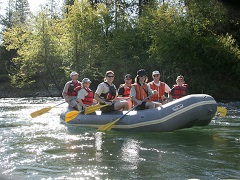BLM opening Trinity River campgrounds May 22
Organization:
BLM Office:
Media Contact:
 REDDING, Calif. – With summer camping season just around the corner, the Bureau of Land Management has announced that Trinity River campgrounds along California State Highway 299 will open Wednesday, May 22.
REDDING, Calif. – With summer camping season just around the corner, the Bureau of Land Management has announced that Trinity River campgrounds along California State Highway 299 will open Wednesday, May 22.
“These are beautiful spots that provide good access to the Trinity River,” said Jennifer Mata, manager of the BLM Redding Field Office. “Camping is a great way for families to connect with nature and learn about the natural wonders to be found on our public lands.”
The Douglas City Campground, west of Douglas City, offers 20 tent and trailer campsites and a riverbank beach. The Junction City Campground, west of Junction City, offers 22 tent and trailer sites. It is a convenient site for travelers on Route 299 between Redding and the coast.
Both areas offer potable water, vault and flush toilets, picnic tables and campfire rings. The fee is $10 per vehicle, per night, at both sites.
The smaller Steel Bridge Campground, about three miles east of Douglas City, has 12 camping sites with picnic tables and fire rings. There are vault toilets. There is no potable water. The fee is $5 per vehicle, per night.
Also open is the less developed Steiner Flat Campground, about two-and-a-half miles west of Douglas City. There are eight sites suitable for tents or small trailers. There is no potable water. Camping is free. There is a nearby boat and kayak launch facility.
Details, including maximum trailer length for each campground, are available by telephoning the Redding Field Office, 530-224-2100.
The BLM manages about 245 million acres of public land located primarily in 12 western states, including Alaska, on behalf of the American people. The BLM also administers 700 million acres of sub-surface mineral estate throughout the nation. Our mission is to sustain the health, diversity, and productivity of America’s public lands for the use and enjoyment of present and future generations.
